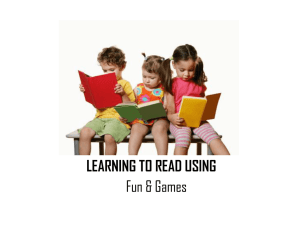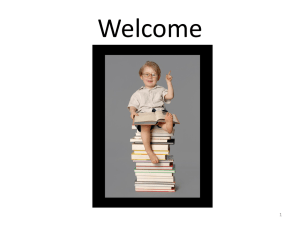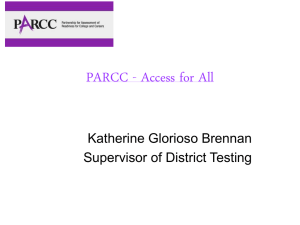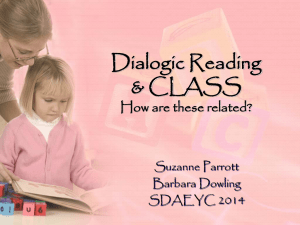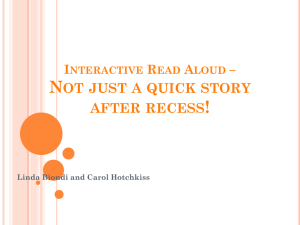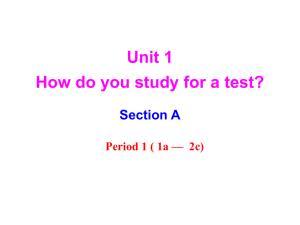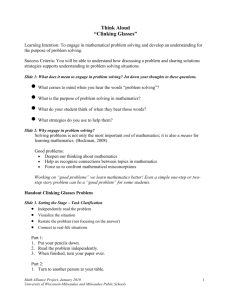PPT
advertisement
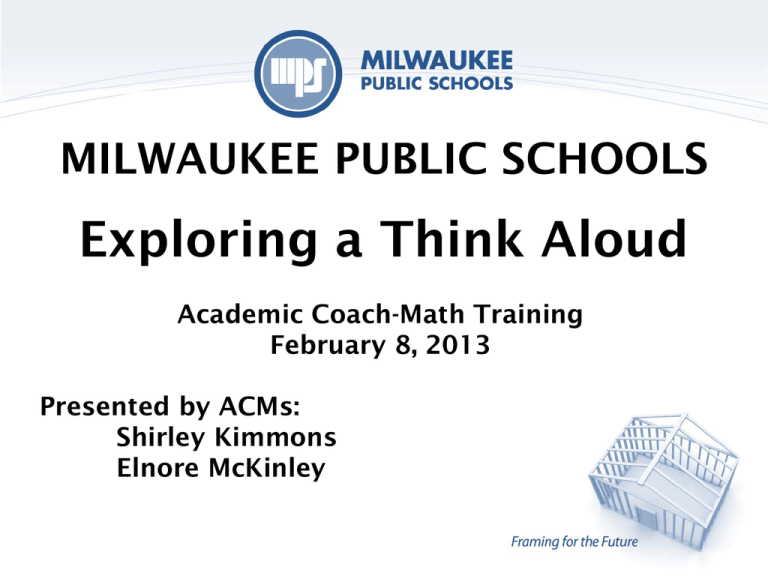
MILWAUKEE PUBLIC SCHOOLS Exploring a Think Aloud Academic Coach-Math Training February 8, 2013 Presented by ACMs: Shirley Kimmons Elnore McKinley Good problem solvers become aware of what they are doing and frequently monitor, or self-assess, their progress or adjust their strategies as they encounter and solve problems. NCTM Principles and Standards, 2000 2 We are learning to deepen our understanding of an instructional strategy to strengthen problem solving skills in all students. We will know we are successful when we can articulate what is meant by explicit instruction and Think Aloud during problem solving. 3 What does it mean to engage in Problem Solving? Jot down your thoughts to these questions: What comes to mind when you hear the “words” problem solving? What is the purpose of problem solving in mathematics? What do your students think of when they hear those words? What strategies do you use to help them? 4 Solving problems is not only the most important end of mathematics, it is also a means for learning mathematics. (Beckman, 2008) Good problems: Deepen our thinking about mathematics Help us recognize connections between topics in mathematics Force us to confront mathematical misconceptions Working on “good problems” we learn mathematics better! Even a simple one-step or two-step story problem can be a “good problem” for some students. 5 MMP Think Aloud Problem Solving Strategy Four Components Setting the Stage-Task Clarification Clarification of Concept and Context-Making Connections Working on the Problem Thinking about the Solution 6 Explicit instruction encompasses a series of teaching components such as modeling, opportunities for students to respond, guided practice, and corrective feedback. Not just telling students the steps you take to compute an answer…but teachers modeling to think aloud the steps and decisions they make when solving a problem. (Silbert, Carnine, & Stein, 1989). 7 Experience a Think Aloud as a 4th grade student. Use your handout paper to reflect on your experience of the Think Aloud. An idea that squares with my beliefs… A point I would like to make. . . A question or concern going around in my head. . . 8 4th grade students This task is presented in the middle of the unit 9 Part 1 Put your pencils down Independently read the problem Visualize the situation Restate the problem (not focusing on the answer) When finished, turn the paper over 10 Sub Sandwiches Last year students in fourth grade took field trips to several places in New York City. Because there were parent chaperones, the students could visit 4 different places on the same day. Four students went to the Natural History Museum, five students went to the Modern Art Museum, eight students went to Ellis Island and the five remaining students went to the Planetarium. The school cooks made large sub sandwiches to be shared for lunch. All the sandwiches were the same size. They gave 3 sub sandwiches to the kids at the Natural History Museum, 4 subs went with the kids to the Modern Art Museum, 7 subs went to with the Ellis Island group, and 3 subs went to the kids at the Planetarium. The next day students were complaining that “it hadn’t been fair”, some students got more to eat than others. Do you agree with the students? Justify your work with words, numbers and pictures. 11 Part 2: Shoulder Partner Retell the problem to each other Do not tell the solution or try to solve the problem Part 3: Whole Group Volunteer: share what you visualized as your thought about the task. Volunteer: Retell the story to whole group 12 Clarify vocabulary specific to the mathematics concepts Clarify vocabulary related to the context of the problem Connect the mathematical ideas to previous work 13 With a shoulder partner: Discuss various approaches for entry into the problem. Share reasoning on approaches. How might you start working on the problem and why? 14 Thinking about the Solution Redefine the question in the problem. Survey students for models of what the solution strategy might look like. Relate connections between the answer, the solution, and the problem. How did you think about the question in the problem? What models were used to help think about a solution strategy? What connections can be made between the answer, the solution strategy, and the problem? 15 Solve the Task Individually solve the problem Share your strategy with a partner Be prepared to share out whole group 16 Debrief: Thinking About the “Think Aloud” Process… Reflect on the Think Aloud” process modeled Discuss with a elbow partner 4 components of the Think Aloud How is this process similar or different to other strategies you have seen in the classrooms or strategies you have utilized? What would be advantages to this strategy? What might be some barriers you could identify? How will you use this strategy in your work as ACM? 17 Poyla’s Four Steps to Problem Solving Understanding the Problem Devising a Plan Carrying out the Plan Looking Back 18 What’s a Think Aloud? Based on a reading strategy, a “Think Aloud” in reading, models what kinds of thinking a good reader uses to comprehend text. The use of a “Think Aloud” for math was developed by a MPS Mathematics Specialist and a MPS Literacy Specialist. MPS implements the strategy differently in mathematics than in reading. The “Think Aloud” process develops independent thinking by students when working in problem solving situations. 19 What does a Think Aloud do? Helps visualize the situation posed Develops important mathematical concepts and connections Clarifies vocabulary Focuses on what is needed for answering and developing points of entry into a strategy for solving the problem 20 We are learning to deepen our understanding of an instructional strategy to strengthen problem solving skills in all students. We will know we are successful when we can articulate what is meant by explicit instruction and Think Aloud during problem solving. 21 Thank You! Shirley Kimmons contact information Kimmonsf@milwaukee.k12.wi.us Hi-Mount Community School K-8 Elnore McKinley contact information mckinlem@milwaukee.k12.wi.us Carson Academy of Science K-8 22 Milwaukee Public Schools Exploring a Think Aloud MPS Board of School Directors Senior Team Dr. Michael Bonds, President Larry Miller, Vice President Mark Sain, District 1 Jeff Spence, District 2 Annie Woodward, District 4 Dr. Peter Blewett, District 6 David Voeltner, District 7 Meagan Holman, District 8 Terrence Falk, At-Large Dr. Gregory Thornton, Superintendent Naomi Gubernick, Chief of Staff Darienne Driver, Chief Innovation Officer Tina Flood, Interim Chief Academic Officer Dr. Karen Jackson, Chief Human Resources Officer Michelle Nate, Chief Operations Officer Gerald Pace, Esq., Chief Financial Officer Anita Pietrykowski, Chief School Administration Officer Denise Callaway, Executive Dir. Community Engagement Patricia Gill, Executive Director, Family Services Sue Saller, Coord. Superintendent’s Initiatives

